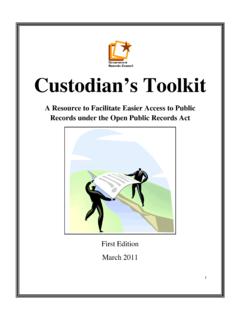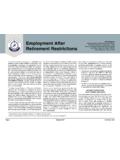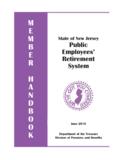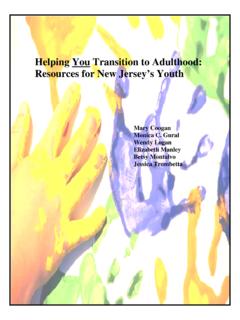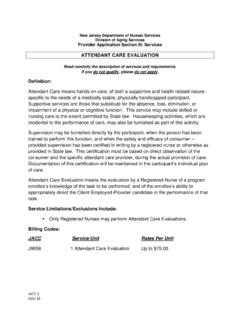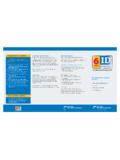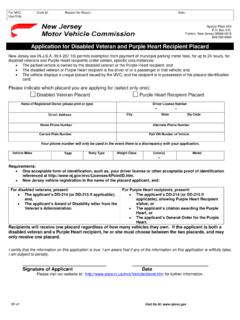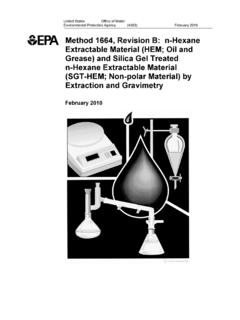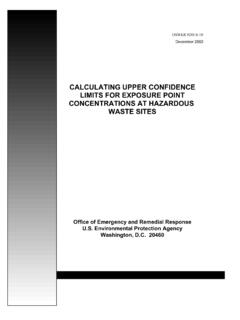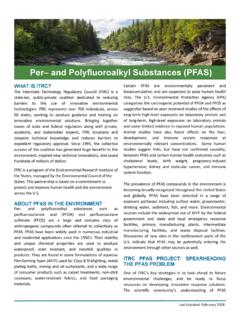Transcription of QUALITY ASSURANCE PROJECT PLAN TECHNICAL …
1 New jersey Department of environmental Protection Site Remediation Program QUALITY ASSURANCE PROJECT plan . TECHNICAL guidance . Version April 2014. TABLE OF CONTENTS. 1 Intended Use of guidance Document .. 1. 2 Purpose .. 2. 3 Document Overview .. 4. 4 5. Conceptual Site Model .. 5. Data QUALITY Objectives .. 6. Data of Known QUALITY Protocols .. 9. Laboratory Accreditation/Certification .. 11. NJDEP Requirements .. 12. 5 QAPP Elements .. 15. Administrative Sections .. 16. Title and Approval Pages .. 16. Table of Contents .. 16. PROJECT 17. PROJECT Definition .. 17. Background .. 17. PROJECT /Task Description.
2 17. PROJECT /Task Organization .. 18. PROJECT Team .. 18. Special Training Needs/Certification .. 19. Data QUALITY Objectives and Criteria for Measurement 19. Precision .. 20. Accuracy .. 20. Representativeness .. 21. Comparability .. 22. Completeness .. 22. Sensitivity .. 23. Historical and Secondary Information / Data .. 24. Investigation Process Design .. 25. Investigation Methods .. 26. Field QUALITY Control .. 27. Field Instrument/Equipment Calibration and Frequency .. 28. Inspection/Acceptance of Supplies and 28. Sample Handling and Custody Requirements .. 28. Field Storage and Transport 29.
3 Analytical Laboratory Requirements .. 29. PROJECT Compounds and Analytical 29. Analytical QUALITY Control .. 31. Laboratory Deliverables .. 32. Data Review and Usability .. 33. Data Management .. 33. Data Verification and Usability .. 33. Reconciliation with User Requirements .. 35. 36. Performance and System Audits .. 36. Corrective Action Processes .. 37. Reporting, Documents and Records .. 37. ii Appendix A References .. A-1. Appendix B Method Specific DQI Tables (QAPP Worksheets .. B-1. Appendix C Glossary .. C-1. Appendix D List of Acronyms .. D-1. iii 1 Intended Use of guidance Document This guidance is designed to help the person responsible for conducting remediation to comply with the New jersey Department of environmental Protection's (Department's) requirements established by the TECHNICAL Requirements for Site Remediation ( TECHNICAL Rules), 7:26E.)
4 Because this guidance will be used by many different people that are involved in the remediation of a contaminated site such as Licensed Site Remediation Professionals (LSRPs), Non-LSRP environmental consultants and other environmental professionals, the generic term investigator will be used to refer to any person who uses this guidance to remediate a contaminated site on behalf of a remediating party, including the remediating party itself. The procedures for a person to vary from the TECHNICAL requirements in regulation are outlined in the TECHNICAL Rules at 7 Variances from a TECHNICAL requirement or guidance must be documented and be adequately supported with data or other information.
5 In applying TECHNICAL guidance , the Department recognizes that professional judgment may result in a range of interpretations on the application of the guidance to site conditions. This guidance supersedes previous Department guidance issued on this topic. TECHNICAL guidance may be used immediately upon issuance. However, the NJDEP recognizes the challenge of using newly issued TECHNICAL guidance when a remediation affected by the guidance may have already been conducted or is currently in progress. To provide for the reasonable implementation of new TECHNICAL guidance , the NJDEP will allow a 6-month phase- in period between the date the TECHNICAL guidance is issued final (or the revision date) and the time it should be used.
6 This guidance was prepared with stakeholder input. The following people were on the committee who prepared this document: Greg Toffoli, Chair, New jersey of environmental Protection (Department), Office of Data QUALITY Nancy Rothman, , New environmental Horizons, Inc. Rodger Ferguson, CHMM LSRP, Pennjersey environmental Consulting Stuart Nagourney (Department), Office of QUALITY ASSURANCE David Robinson, LSRP, Synergy environmental , Inc. Joseph Sanguiliano (Department), Office of Data QUALITY Phillip Worby, Accutest Laboratories, Inc. 1. 2 Purpose The purpose of this document is to provide guidance on the development and use of QUALITY ASSURANCE PROJECT Plans (QAPPs) associated with the remediation of sites for the New jersey Department of environmental Protection (Department) Site Remediation Program (SRP) as required by the TECHNICAL Rule, at 7 All other applications or use of this TECHNICAL guidance at non-SRP sites or properties is beyond the scope and authority of the SRP.
7 Regulations. This document has been developed to assist Licensed Site Remediation Professionals (LSRPs), Department case reviewers and/or managers, and other environmental professionals, collectively the investigator, to obtain scientifically reproducible and reliable data, , Data of Known QUALITY Protocols (DKQP), that meets the Data QUALITY Objectives (DQOs) established for the investigation and remediation of the contaminated site. The intent of this TECHNICAL guidance is to provide guidance for investigators to address the majority of SRP sites where data collection is required as part of the remedial process.
8 QAPPs are the primary result of a systematic planning process and are used to document the results of planning, to implement environmental operations, and to assess PROJECT data. It is important to remember during the QAPP development process that data QUALITY is an issue because of the possibility of both variability and error in sampling and analysis. The natural environment is inherently variable; nothing stays the same from time-to-time or from place-to- place. In addition, all of our measurement processes are flawed to some degree, imposing error on top of the inherent variability. The QAPP documents the results of the PROJECT 's TECHNICAL planning process, providing a single and concise plan for the collection and management of environmental data and the DQO.
9 While making sure to cover all of the elements described herein, the investigator should not let this guidance in any way limit the team's investigation of alternative materials that might be useful for understanding the substance or rationale for the PROJECT . In addition, this guidance is most applicable to environmental monitoring projects that do not involve extensive modeling or research components (for modeling projects, see United States environmental Protection Agency (USEPA), guidance for QUALITY ASSURANCE PROJECT Plans, EPA QA/G-5, December 2002, EPA/240/R-02/009). 2. The QAPP should be prepared by the investigator in cooperation with representatives from all groups ( , Investigator, Laboratory, Driller, the Department, etc.)
10 Expected to be involved in the PROJECT . It should be completed before environmental data collection or use activities begin. When changes in the PROJECT will affect the TECHNICAL or DQO of the PROJECT , the QAPP will need to be amended with notification of all PROJECT participants. QAPPs for multi-year projects should be reviewed periodically and revised when necessary. This QAPP guidance should be used in concert with other Department guidance documents, the Regulations Implementing the Underground Storage of Hazardous Substances Act ( 7:14B), the Industrial Site Recovery Act ( 7:26B), the TECHNICAL Requirements for Site Remediation ( 7:26E), and other relevant and applicable regulations.

